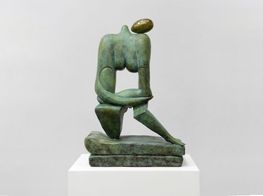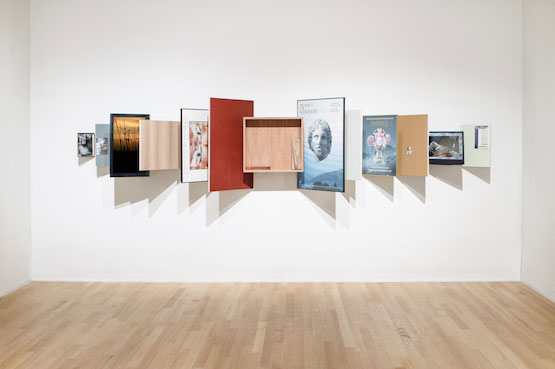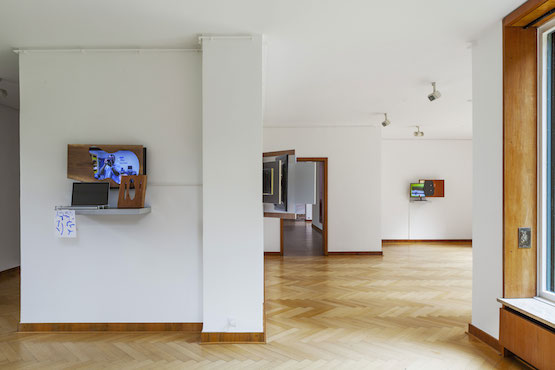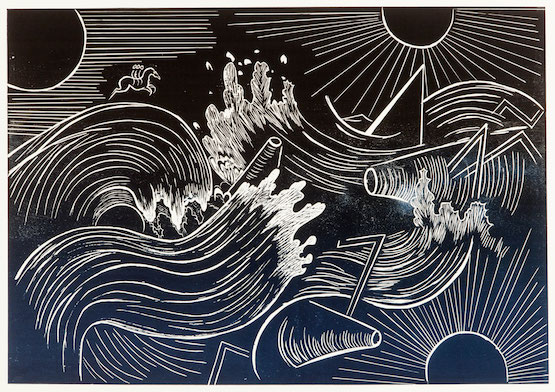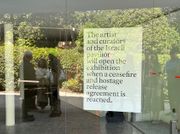Camille Henrot on Grosse Fatigue
Camille Henrot. Photo: © Joakim Bouaziz.
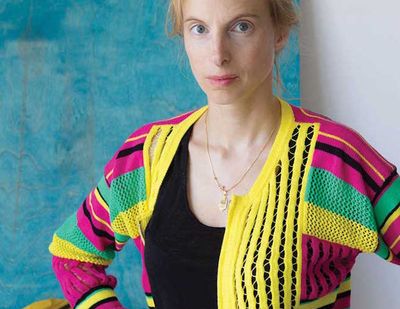
Camille Henrot. Photo: © Joakim Bouaziz.
Camille Henrot's Grosse Fatigue (2013), translated as 'great exhaustion', is a 13-minute video that performs an 'intuitive unfolding of knowledge'.
The work is articulated through the presentation of a continual flow of images over a computer desktop. A voice narrates a story over these images, which are sourced from Google and the collections of the Smithsonian Institution in Washington, D.C. (where this project was produced as part of the Smithsonian Artist Research Fellowship Program). It tells the story of the universe: a kind of mashed-up creation myth that combines elements from mythical, religious, historic, and scientific narratives; and origin tales from various cultures, including the Sioux, Navajo, Inuit, and Shinto. The result is a totalising tale: of a beginning and an end, from the origins of the universe, to an ultimate demise.
Grosse Fatigue was presented at the 2013 Venice Biennale and was awarded the Silver Lion. This was followed up with Henrot's solo exhibition titled The Pale Fox at London's Chisenhale Gallery in 2014 and a survey show of the artist's work at the New Museum in New York, The Restless Earth. Most recently, Henrot became the recipient of the Nam June Paik Award, initiated and fully supported by the Arts Foundation of North Rhine-Westphalia and selected by jurists Thomas Y. Levin and Dirk Snauwaert. The award is intended to recognise excellence in media art, with a special consideration as to how nominated and awarded practices relate to the legacy of Nam June Paik. 2014's shortlist included Cory Arcangel, Ulf Aminde, and Thomson&Craighead. The works of all four artists are on show at the Museum Haus Lange of the Kunstmuseen Krefeld to February 2015.
In this interview, Henrot, who originally studied animation, discusses the concepts she investigates in her recent work.
SBDo you see Grosse Fatigue as a keystone work for you in terms of thinking about how to structure vast amounts of information into a cohesive, comprehensible form?
CHGrosse Fatigue was made during my Smithsonian Artist Research Fellowship in 2013. I was very intimidated by the institution and overwhelmed by the quantity of information it holds. I wanted to research everything and couldn't exclude anything. It felt like the Smithsonian in its ambition in some ways symbolised American culture. As a recent expatriate, I'm still fascinated by the way huge ambition and childish attitudes coexist here.
Even while I was working on the project, I knew that my approach was changing. In the past, I had been interested in the connections and dialectics between universality and specificity, the general and the particular, and how this tension is co-reflected in aspects within all societies; and ultimately implied in humans' relation to time. As I was writing my proposal for the Smithsonian, I realised that the articulation of the particular and the specific and dealing with primary emotions—fear, sexual desire, aggression—was at the root of every all-encompassing, global strategy.
SBHow does this relate to your previous work?
CHSince my ikebana project in 2012, Is it possible to be a revolutionary and like flowers?, big systems, taxonomies and totalising structures have inspired in me a sort of fascination and distrust that I find stimulating. They compel me to wonder how to dismantle them and then rebuild them myself. I was lucky that what I had done or read before was so helpful in this research. But to be honest, it was also a painful moment. I was feeling overwhelmed by the knowledge I was accumulating, and I had just moved to the U.S. My boxes were held in customs, and I was working from my bed most of the time. All of this informed the work I was doing, too.
The massive accumulation of knowledge and the effort to synthesise it could be described as a journey from the subjective to the collective, which ultimately returns to constitute individual subjectivity. This urgent desire to connect and totalise also relates to feelings of isolation and loneliness, as the effort to embrace a totality resembles the desire of the individual to reach beyond her own learning capacities.
SBWhich brings us back to Grosse Fatigue...
CHThe more information you have access to, the more unhappy you're likely to be, and Grosse Fatigue—consider even just the title—is connected to this. In mythology, too, knowledge is something that makes people unhappy. I wouldn't say this is always true—in 'Rabelais', for instance, it's the opposite. Literature and poetry give me so much pleasure because they are forms of knowledge that are fulfilling.
By contrast, anthropology or philosophy are always stimulating and a little therapeutic, but at the same time they add to your problems. Knowledge is a kind of drug that makes you unhappy but also gives you a sense of relief. I feel like that's my general relationship to information—I get excited about an idea temporarily, I'm happy about discovering new things, and then it slowly becomes too much. I am also frustrated to perceive the limits of my own access to knowledge. Any experience of building knowledge is always frustrating. It's very banal and I hate to say it, but the more you know, the more you discover you don't know, like in the Buddhist stories.
SBYou have said that you viewed the process of making Grosse Fatigue as a kind of poetry. I wonder if you could elaborate on this when thinking about visual language as a kind of writing?
CHWhen writing, you are confronted with endless possibilities. It's different from making a sculpture or a film where you immediately hit your head against a wall and are constantly confronted with restrictions. I usually never have voice-over in my films because my conception of moving images is very much inspired by experimental cinema and avantgarde cinema of the 1930s where the image and sound interact more in a rhythmic way than a narrative way.
For Grosse Fatigue it was different because the topic was more easily reachable with a textual approach, especially because that is the way the story of the universe has been told for centuries in creation myths. Also I felt like a voice-over is what's missing when we are exploring the world through the internet.
To expand on the main differences between oral culture and internet—and to elucidate what I believe makes the first superior in an ethical and biological way—is that in oral culture, things are kept active in a living memory as opposed to being flattened and put on the same line by a research motor. Memory is a natural way of producing hierarchy in information, which is also what you do when you write, because that is the only way that narratives are possible. When telling a story you need to choose which elements to tell and which elements to keep silent.
Among all forms of writing, poetry is the closest to oral culture. Poetry is what can be read aloud, and it is what children learn at school to train their memory. I always felt this was the most important aspect of education, knowing poetry by heart. We were very much thinking about this when writing the voice-over with Jacob Bromberg, as the text was written to be spoken aloud and we would perform it frequently while editing. It makes me think that in fact another book that has been influential for a very long time is Herbert Marcuse's L'homme unidimensionnel. There is this idea at the end of the book that in a controlled environment where pleasure, Eros, has been totally kidnapped or instrumentalised to serve the purpose of capitalism and not the one of erotic pleasure, the most ethical thing to do in this world is to try to remember.
SBThis question is a bit of a wildcard, but what are your thoughts on the label 'post-internet'? How would you define the term and do you see yourself fitting into its frame?
CHYou will never find an artist who enjoys having a label on, but like any label it's a useful tool for some people. It's hard to have an opinion on 'post-internet' because I'm having a hard time understanding what it really means. I first misunderstood it and thought that post-internet was a generation of artists who resisted the internet and abstained from using it in their life and work—a sort of political movement.
As a title it sounds clumsy because if the internet has brought a specific approach it would be a sort of horizontality or flattening, which we have yet to move beyond. The prefix 'post' implies historicity—I think 'post' looks a bit old-fashioned connected to internet. Just as it has impacted all types of people, the internet has influenced massively the way that artists work and think. I'm now trying to compare this to how artists reacted to photography, cinema or television, but the difference with the internet is that it's more all-encompassing: it's active and passive, it has to do with any kind of activity from buying dog food to researching in a library or flirting. What is the effect of having all these diverse activities that belong to different mental spaces tied together?
SBWhat advice would you give young artists working today? What are the important things to remember when deciding to become an artist in the 21st century, when thinking about the art world and its systems?
CHDon't read the press, sleep as much as possible; be concerned about your environment.—[O]

